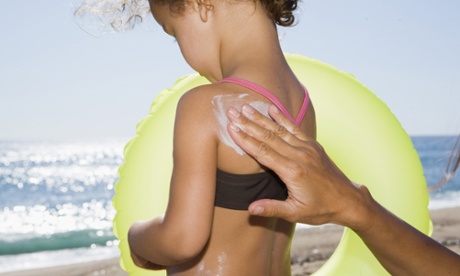
Manufacturers of sunscreen products are being urged to introduce simpler labelling after a survey revealed confusion about the dual protection ratings currently in use.
Research by the Royal Pharmaceutical Society (RPS) showed that many consumers are unaware that the SPF rating displayed on labels does not guarantee good all-round protection from potential sun damage.
The society said ignorance of the issue could be putting people at greater risk of skin damage and cancer.
Suncreams are designed to protect skin from UVA and UVB radiation, which may increase the risk of developing skin cancer. SPF indicates the amount of protection offered against UVB, which is the main cause of sunburn. Protection from harmful UVA rays is typically indicated by a separate star rating.
In a survey of 2,000 adults carried out for the RPS, 8% knew that the SPF rating refers to protection from UVB rays only. Most said either they thought the SPF was an indication of levels of protection from both UVB and UVA (56%), or they did not know what the rating stood for (25%).
Less than a third of those surveyed said they always checked the UVA star rating when buying sunscreen, and 20% of students and 15% of adults with children in their household admitted that they never bothered to check it.
The society’s chief scientist, Prof Jayne Lawrence, said: “This survey indicates that there is a huge amount of confusion around sunscreen labelling that is a barrier to effective sun protection. Clearly many consumers do not realise the SPF rating applies only to the amount of protection offered against UVB rays, not UVA rays – both of which can damage the skin and cause skin cancer.”
Lawrence said consumers should not have to pick their way through complicated dual ratings information to understand how sunscreen works and the amount of protection it potentially provides. “We think it’s time for sunscreen manufacturers to provide one easy to understand rating, based on a simple description of the total amount of sun protection offered: low, medium, high and very high protection.
“People have largely got the message that they must protect their skin from the sun using sunscreen, along with other precautions such as covering up and keeping out of the sun during the hottest part of the day. The RPS is calling for one uniform measure for all sun protection products, so pharmacists can provide easy to understand advice on the effectiveness of products and how they should be used.”
Rates of malignant melanoma (skin cancer) have been steadily rising in the UK since the mid-1970s. Some of the increase may be due to better awareness and early detection as well as changes in diagnostic criteria, the RPS said, but it is also linked to more holidays being taken abroad and sunbed use.
A study by Cancer Research UK published in December 2011 estimated that around 86% of skin cancer cases in the UK in 2010 were linked to exposure to UV rays from the sun and sunbeds.
Less than half (44%) of the consumers surveyed by the RPS said they always or often used sunscreen when out in the sun, and 31% either did not know how much lotion to apply (CRUK recommends two tablespoons) or understimated how much to apply to ensure protection.
Only 13% said they reapplied sunscreen every two hours as recommended when out in sunny weather.

